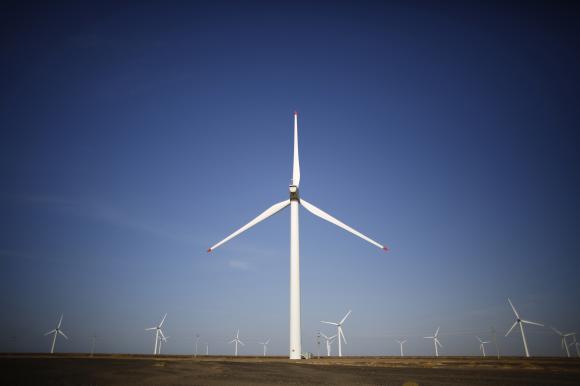Step up action to curb global warming, or risks rise: U.N.
Date: 14-Apr-14
Country: International
Author: Alister Doyle

Wind turbines used to generate electricity are seen at a wind farm
in Guazhou, 950km (590 miles) northwest of Lanzhou, Gansu Province
September 15, 2013.
Photo: Carlos Barria
The study, drawing on work by more than 1,000 experts, said a radical shift from fossil fuels to low-carbon energy such as wind, solar or nuclear power would shave only about 0.06 of a percentage point a year off world economic growth.
"It does not cost the world to save the planet," Ottmar Edenhofer, a German scientist who is co-chair of a meeting of the U.N.'s Intergovernmental Panel on Climate Change (IPCC), told a news conference in Berlin.
The report, endorsed by governments, is meant as the main scientific guide for nations working on a U.N. deal to be agreed in late 2015 to rein in greenhouse gas emissions that have hit repeated highs this century, led by China's industrial growth.
"We don't have the luxury of time," Rajendra Pachauri, chair of the IPCC, told Reuters, saying costs would rise sharply if strong action was delayed to 2030. "We will have to move quickly and with an unprecedented level of international cooperation."
Governments have promised to limit temperature rises to a maximum 2 degrees Celsius (3.6 Fahrenheit) above pre-industrial times to avert ever more heatwaves, floods, droughts and rising sea levels that the IPCC says are linked to man-made warming.
Such levels were still attainable, it said, but policies in place so far put the world on target for a temperature rise of up to 4.8C (8.6F) by 2100. Temperatures have already risen by about 0.8 C (1.4F) since the Industrial Revolution of the 18th and 19th centuries.
IPCC scenarios showed world emissions of greenhouse gases, mainly from burning fossil fuels, would need to peak soon and tumble by between 40 and 70 percent from 2010 levels by 2050, and then to almost zero by 2100, to keep rises below 2C.
The IPCC said that natural gas, which emits fewer greenhouse gases than coal, could get a boost until about 2050.
"Ambitious mitigation may even require removing carbon dioxide from the atmosphere," the IPCC said. Delay in acting to cut emissions until 2030 would force far greater use of such technologies, a 33-page summary for policymakers said.
RISKY OPTIONS
One method would be to burn wood, crops or other biomass to generate electricity, capture the greenhouse gases from the exhaust fumes and bury them underground, it said.
The experimental technology would reduce the amount of carbon in a natural cycle of plant growth and decay. But there are risks, such as the need for vast land areas to grow biomass, which would displace crops and push up food prices.
A simpler method to remove these gases from the air is to plant trees that soak them up as they grow, the IPCC says.
The report did not mention "geo-engineering" options, such as placing giant mirrors in space to bounce sunlight away from the Earth. "At this point in time, it's not a policy option, Pachauri said.
Many world leaders welcomed the IPCC report, even as it underscored they were not doing enough. "This report makes very clear we face an issue of global willpower, not capacity," U.S. Secretary of State John Kerry said.
European Union Climate Commissioner Connie Hedegaard said: "The report is clear: there really is no plan B for climate change. There is only plan A: collective action to reduce emissions now."
U.N. Secretary-General Ban Ki-moon hoped world leaders would bring "ambitious announcements and actions" to a summit in New York in September to map out ways to fight global warming.
The IPCC report is the third and final part of a massive United Nations series, updating science for the first time since 2007. A summary of findings will be issued in October.
The IPCC says it is at least 95 percent probable that man-made emissions are the main cause of warming. But many voters are doubtful, suspecting that factors such as the natural vagaries of the weather or sunspots might be to blame.
Low-carbon energies, which accounted for 17 percent of world energy supplies in 2010, would have to triple or quadruple their share by 2050, displacing conventional fossil fuels as the top source of energy, IPCC scenarios showed.
Low-carbon energy can include coal-, natural gas or oil-fired power plants if they use carbon capture and storage (CCS) to bury emissions underground. That technology, however, is mostly experimental, and costly.
(Editing by Tom Heneghan)